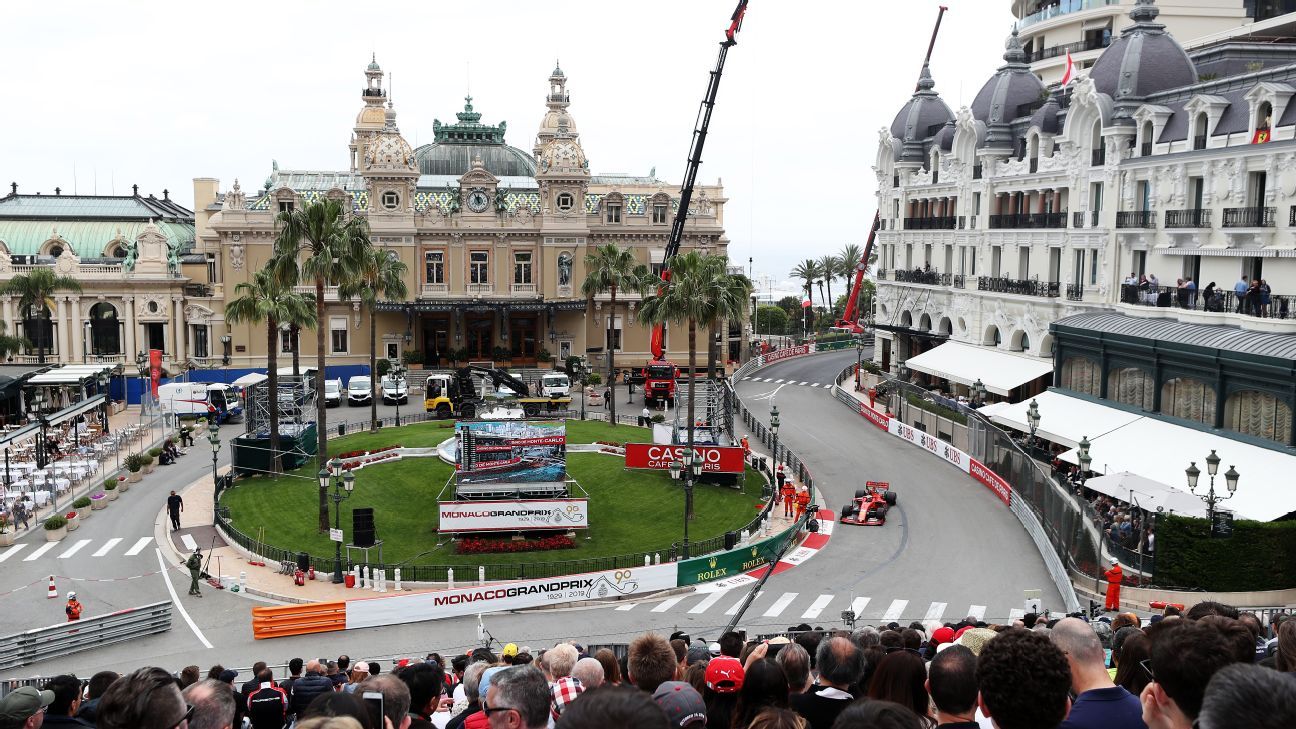F1 editor Laurence Edmondson reports from his favourite trackside spot during Thursday’s opening practice session.
MONTE CARLO, Monaco — In terms of real estate value, Casino Square is probably the most expensive patch of land in sport. The famous Monte Carlo Casino stands on one side of the square, flanked by the Hotel de Paris to its left and the Cafe de Paris on its right. A glance at the cafe’s menu lets you know you’re in the land of the super-rich, with a latte macchiato costing €8 and a Nicoise salad setting you back €22. But if you’re planning to stay in the area for more than just a light lunch, it’s wise to check with your bank manager first as a night in a standard room at the hotel will cost €5,000 and you’ll need over €20,000 per night for a trackside suite.
For the majority of the year Casino Square is a tourist trap. Supercar owners peacock past the fountain at low revs, while day trippers snap photos as they queue for tours of the casino. In the evening the high-rollers arrive in their Rolls Royces and Maybachs and head straight for the private gambling rooms, where only a members card will grant you access and there is no upper limit on the maximum bet. But for a fleeting seven seconds on Saturday afternoon this millionaires’ playground will host to two corners of the most awe-inspiring qualifying lap of the Formula One season.
The trickiest part of the Casino Square complex comes just before the drivers enter the square itself. Reaching the top of Beau Rivage after a flat-out run from Turn 1, the cars arrive at 170mph before dropping three gears and taking the apex of Massanet at just over 100mph. The throttle is then squeezed again before another dab of brakes ahead of the right-hander at Casino, followed in quick succession by a crest in the road that loosens the rear of the car on the exit. It is not the most difficult part of the two-mile circuit, but standing on the other side of the barriers it offers one of the most dramatic trackside experiences on the F1 calendar.
The best point to stand is on the outside of the corner just after the crest. There is no kerbing or tyre barrier here, just an Armco barrier and chain-link fence separating onlookers from the circuit. The first you see of the car is the drivers helmet as he takes the apex at Casino before the rest of the car lurches into view over the crest. There are few places on the calendar where you can guarantee to see a Formula One car sideways, but at this section of track as many as one in five will spin the rear tyres over the crest, forcing the driver to catch a slide on the exit.
Unlike two thirds of the Monaco circuit, this section of track has not been resurfaced this year. It means you still have all the regular road markings, including a crosswalk just after the apex of the right hander and a yellow zig-zagged no-stopping section as the cars run up against the barrier. There is a small opening in the fencing for a marshals’ post where two members of the Automobile Club de Monaco stand watching on — one clutching a blue flag for warning drivers of faster cars behind and one holding a yellow flag to warn drivers of an accident further around the circuit. A red flag leans against the barrier, comfortably within reach in case a big accident causes the session to be suspended.
With grip still at a premium during the first practice session on Thursday morning, Valtteri Bottas was the most spectacular driver through this section. The revs of his Mercedes engine routinely peaked as he went over the crest but each time he measured out the necessary counter-steer to prevent his rear tyres slapping the barrier. The slide itself is over in a split second, and probably looks far more dramatic from the outside than it feels inside the car, but is enough to quicken the pulse and convince you to take a step back from the barrier.
The following straight takes the drivers downhill as they start their descent back towards the Mediterranean. It has a large bump on the left where the Avenue Saint-Michel would normally join the piece of track that runs from Casino Square to the next corner at Mirabeau. On any other circuit such a peculiarity would have been ironed out years ago, but here it has to remain in order to prevent Monaco’s regular traffic of buses and supercars scraping the tarmac as they make a turn at the junction.
Over the race weekend, the bump acts as a mini chicane midway down the straight, forcing drivers to jut right then left to avoid bottoming out. But even allowing for the evasive action, the floors of the Red Bulls were still sparking all the way to Mirabeau as the team went in search of the optimum ride height on Thursday morning. Unfortunately, there are no grandstands at that part of the circuit to witness the fireworks, but among a series of closed banks and estate agents on the left-hand side, the front of the famous Tip Top bar remained open. Legend has it that five-time Monaco winner Graham Hill used to dance on the tables of the small bistro as he partied late into the night following a race victory. Nowadays, however, it it is mainly frequented by tourists in search of a beer for under €10.
During the session the bar was empty save for an immaculately-dressed older couple — the man sat in the only chair not stacked on a table and his wife stood by his side. Judging by the size of his lapels, the man’s tailor had not changed since the 1970s, and his wife completed the retro look in a white twinset and pearls. If it wasn’t for the sound of hybrid engines on the other side of the barrier, you could be convinced you’d been transported back three decades, with James Hunt and Niki Lauda whizzing past on the way down to Mirabeau.
There truly is nowhere like Monaco.
The tunnel
Nate Saunders is attending his first Monaco Grand Prix this weekend — his first taste of Monte Carlo trackside came during FP2.
You know that noise Sacha Baron Cohen’s Borat character makes when he’s happy? “Wa-wa-wee-wah”? That is nonsensical enough of a phrase to convey how difficult it is to put into words the sensation from standing alongside certain points of the Monte Carlo track on Thursday afternoon. It started at the kink in the city’s famous tunnel, possibly the most iconic stretch of race track on the F1 calendar. It did not disappoint.
You may have heard that the V6 turbo engines are quiet, and they can be. Not here. Through the tunnel, the cars feel like they are in your bones. You can hear the noise approaching early on and then it rips past you, echoing and reverberating. When there are several coming through in quick succession the place is a crazy mix of sounds at different levels, bouncing around you. Funnily enough, on my walk back to the paddock at the end of FP2 I bumped into a colleague who told me that an old member of the British F1 press corps attributes a foolhardy, pre-V6 turbo era trip to the tunnel without earplugs, to the ongoing hearing problems he’s had since. I can see why — my ears were still burning at the end of the day.
It was comparable to one other experience of my journalistic career so far — sitting on the pit-wall at the 2017 Indy 500, where I had kindly been invited the opening laps to watch by a team, when the 33 cars all roared past in a flash at the end of the formation laps to start the race. That one nearly knocked me off my seat. The tunnel was special and it’s a shame that sensation cannot be conveyed to a fan watching it at home.
A move down to the chicane might slow the speed down considerably but is actually more revealing about each individual car, albeit skewed by whatever each was doing at that particular point of practice. But it’s easy to make observations. The Toro Rosso doesn’t like kerbs too much. The Williams looked slow everywhere. The Ferrari looked a bit lazy, with Sebastian Vettel and Charles Leclerc having to work quite hard to get it through the corner. The Mercedes might as well be racing on a different planet — the ease with which it found traction coming out of the corner was unfair when compared to the others.
A further walk down alongside Tabac reveals a Monaco quirk — a gap of clear blue water between the edge of the harbour and the line of yachts full of people watching the action. Any boat in this line is required to move back whenever a track session is in full swing. It’s a reminder that in some of the absurdity of this little principality’s most famous event, rules for safety still exist and are adhered to rigidly. Despite the small gap to the harbour’s edge, these boats are still packed, full of people clutching champagne flutes and cameras, watching the incredible spectacle roaring by under their noses.
Beyond Tabac is another brilliant spot to watch racing from — the first Swimming Pool chicane. This has always been one of my favourite points on this race track when watching through the medium of onboard laps, one of the many section of this circuit where a bit of bravery can be the difference between pole position and second on the grid. The drivers come flat through the Tabac left-hander, then swing left for the entry and immediately swing right for the exit, with the quick but unmistakeable ‘duhhhn-duhhhn’ sound of both left-side wheels rumbling over the kerbs on the exit as they do so. At this point, former Benetton and Williams driver Alexander Wurz was sitting on the inside of the corner, taking pictures through one of the gaps in the barriers, looking pretty blown away by the speed of the cars whistling past him just the other side of an Armco barrier.
Then there is the second Swimming Pool chicane, immediately afterwards. Here you can go and stand in a gap in the fencing just before the braking zone– my paddock pass would blow up in the air each time a car roared past me, I was that close. The power of F1 brakes is staggering and here is one of the best places to see it — drivers stop so suddenly but yet so smoothly, then hit a quick right as close to the inside barrier as they can get, then across the exit kerbs and towards the final portion of the circuit. I had been at Casino Square for the FP2 qualifying simulations — Laurence does a good job above of conveying the sensation of standing there — so by the time I came the cars were clearly running with a bit more fuel, with less grippier tyres, but it was still impressive how quick they were through the whole section. Again, as with the chicane after the tunnel, Mercedes was just able to get on the throttle earlier than its rivals.
The whole experience did make me consider something about F1 coverage of its cars. Up close, they look raw — they twitch, they bounce over uneven bits of road, they sometimes snake from side to side while carrying speed through a corner. Modern day onboards, powered by state-of-the-art technology and stabilised cameras, ruin some of those sensations and gives the impression that driving an F1 car is far easier than it should be. Ninety minutes stood alongside this ridiculous, awe-inspiring circuit would be ample time to dismiss any such suggestion from someone’s mind.


